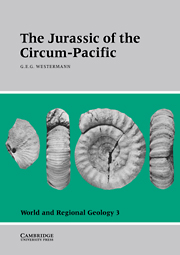Book contents
- Frontmatter
- Contents
- List of contributors
- Preface
- Acknowledgments
- Introduction
- Part I Time scales
- Part II Circum-Pacific base map
- Part III Regional geology and stratigraphy
- 4 Western Canada and United States
- 5 Meso-America
- 6 Western South America and Antarctica
- 7 Australasia
- 8 Indonesia and Papua New Guinea
- 9 Southeast Asia and Japan
- 10 Eastern China
- 11 Eastern Russia
- Part IV Biochronology
- Part V Biogeography
- Part VI Climatology and oceanography
- Appendix: Biochronology and atlas with index and guide fossils
- General Index
- Index of Guide- and Indexfossils
4 - Western Canada and United States
Published online by Cambridge University Press: 04 August 2010
- Frontmatter
- Contents
- List of contributors
- Preface
- Acknowledgments
- Introduction
- Part I Time scales
- Part II Circum-Pacific base map
- Part III Regional geology and stratigraphy
- 4 Western Canada and United States
- 5 Meso-America
- 6 Western South America and Antarctica
- 7 Australasia
- 8 Indonesia and Papua New Guinea
- 9 Southeast Asia and Japan
- 10 Eastern China
- 11 Eastern Russia
- Part IV Biochronology
- Part V Biogeography
- Part VI Climatology and oceanography
- Appendix: Biochronology and atlas with index and guide fossils
- General Index
- Index of Guide- and Indexfossils
Summary
INTRODUCTION
Prior to the general acceptance of the theory of plate tectonics, western North America was both a classic model and an enigma for structural geologists captivated by the eugeosyncline–miogeosyncline paradigm. Soon after the theory of plate tectonics settled in, accreted terranes followed, pioneered by one of the leaders of the plate-tectonic movement (Wilson 1968). Western North America, unique among the various boundary regions of the Pacific Ocean in being dominated by thin slivers of accreted terranes separated by transcurrent faults (Howell and Jones 1989), has played a leading role in the development of the concepts of terrane accretion. Insofar as the Jurassic was a primary period of accretion, the Jurassic rocks in western North American have played a major role in these developments.
The North American continent that split away from Europe during the Jurassic is estimated to have been 20–30% smaller than at present and to have grown by 300–500 km along its Pacific Coast by the accretion of about 100 terranes between 200 and 50 m.y. ago (Figure 4.1 A). The western margin of North America prior to about Middle Jurassic time was a passive margin (miogeocline), with mainly cratonic sediment sources, persisting 450 m.y. since a major Late Proterozoic rifting event (Sloss 1982; Stott and Aitken 1982).
- Type
- Chapter
- Information
- The Jurassic of the Circum-Pacific , pp. 29 - 92Publisher: Cambridge University PressPrint publication year: 1993
- 3
- Cited by



